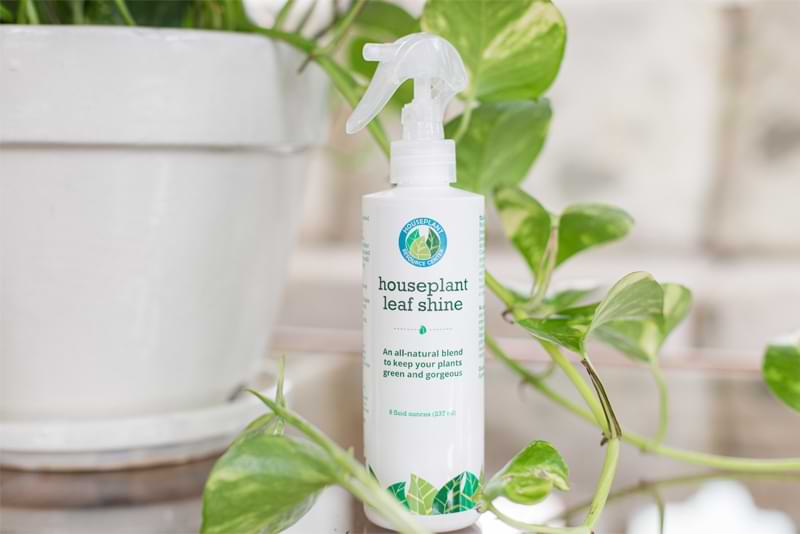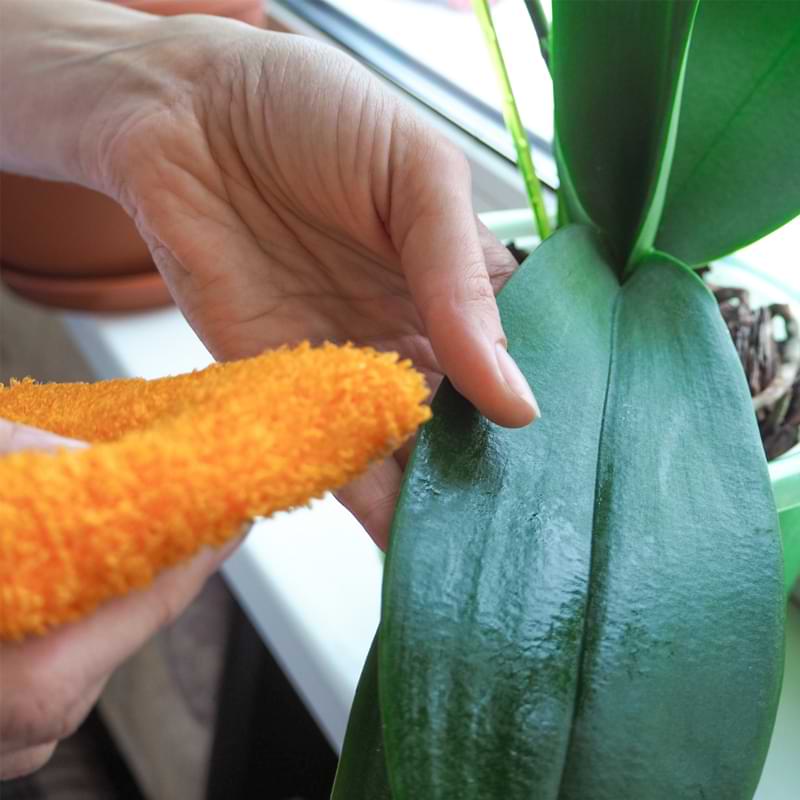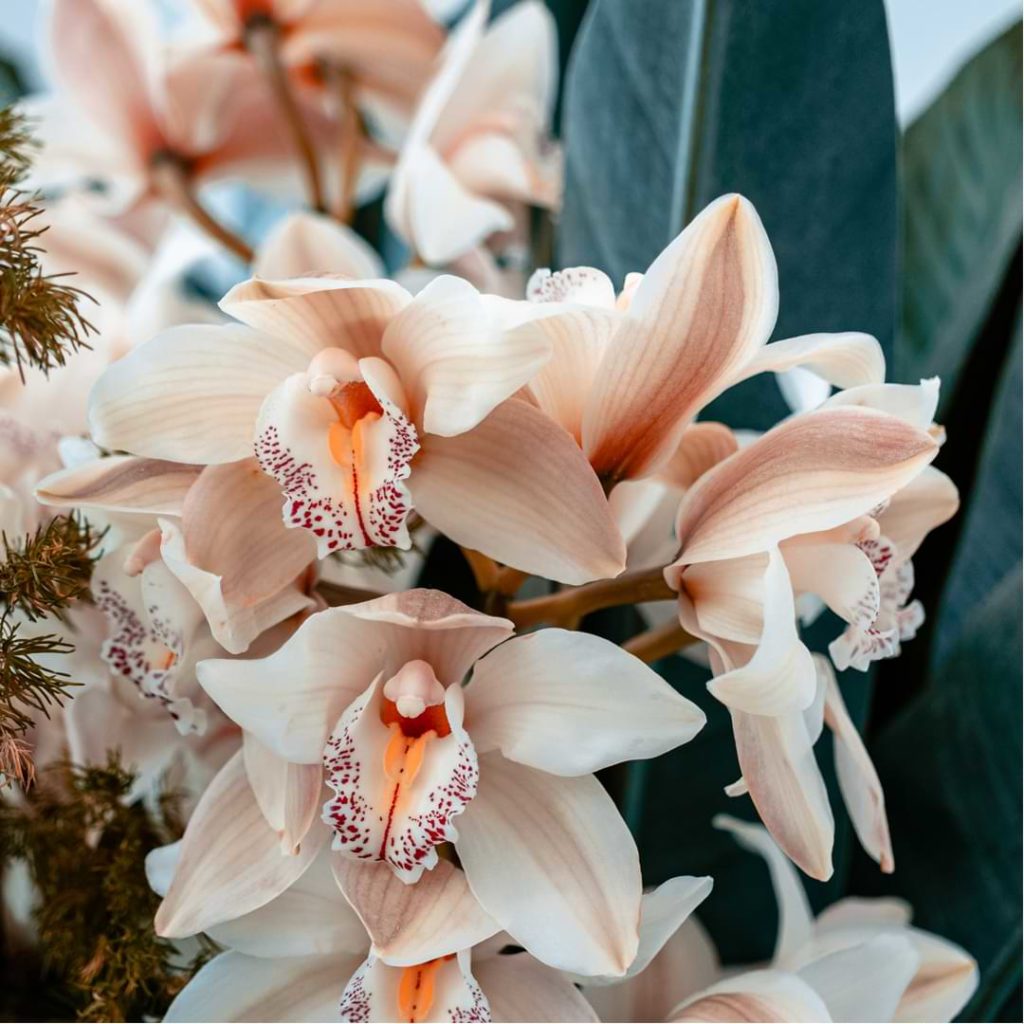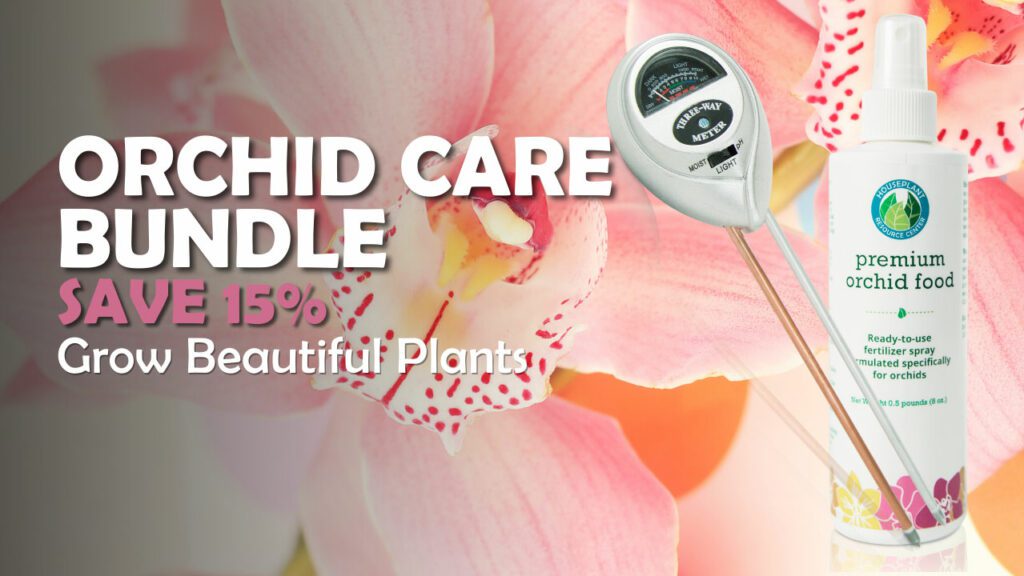Orchid flowers may be the star of the show, but shiny, glossy leaves add to an orchid’s appeal. When leaves are in their best state, they can look so lustrous that they almost appear fake. Keeping the leaves this healthy-looking requires some work, but cleaning your orchid leaves can transform your orchid from eye-catching to outstanding.
Why Are My Orchid Leaves Dull?
Some orchids seem to have impossibly glossy leaves. However, if you’ve had an orchid in your home for a while, you’ve probably noticed over time that the leaves seem to have lost their luster.
Orchid leaves are dull for one of two reasons. The first reason has to do with the health of the orchid. These plants may have dull leaves if they are not getting enough water. If its environment does not provide enough moisture, an orchid’s appearance begins to suffer.
The second reason that orchids get dull leaves has to do with the buildup of dust or mineral deposits on the leaves. In this case, the loss of shine occurs gradually as particles gather on the plants. The good news is that it is easy to reverse this problem.
Benefits of Clean Orchid Leaves
Obviously, cleaning orchid leaves makes them look more attractive. Returning orchids to their original, shiny state makes them especially eye-catching.
In addition to appearance, clean orchid leaves also have practical benefits for the plant. A clean leaf allows orchids to absorb moisture and breathe better. As you no doubt learned in high school science, plants exchange oxygen and carbon dioxide through the stomata, pores on the leaves that open and close. Buildup on leaves hinders this exchange process.
Clean leaves can also help you keep any pests under control. While shiny leaves do not deter pests from making their home on your orchid, the clean surface makes it more likely that you will notice pests earlier. This can allow you to take steps to get rid of pests before they begin to damage your orchid.
Can You Wet Orchid Leaves?
You might be wondering whether or not it is safe to get orchid leaves wet. It seems like houseplant lovers are constantly warned not to allow their plants’ leaves to get wet when watering out of fear of causing rot or allowing fungus and bacteria to develop.
However, wetting orchid leaves is not as dangerous as many people proclaim. After all, a glance outside during a rainstorm can confirm that plants are made to handle getting wet. Orchids are native to a tropical environment, so they are no strangers to wet conditions.
The key difference is that air flow in the natural environment dries off orchid leaves within a matter of hours. In most households, there is not as much air movement and water can remain on orchid leaves for longer if they get wet.
Leaves that remain wet for too long do have a higher chance of having problems with bacteria, fungus, and rot developing, but this doesn’t mean that you can never wet orchid leaves. It just means that you need to be aware of how quickly your orchid leaves are able to dry after getting wet. If you take steps to increase airflow such as adding fans around your orchids after wetting their leaves, you should not have the issues that sometimes pop up when leaves remain wet for too long.
How Do I Make Orchid Leaves Shiny?
Looking to return your orchid leaves to the glossy state that they (hopefully) had when you first got them? Then you can clean off your orchid leaves to remove the buildup.
What Is the Best Thing to Clean Orchid Leaves With?
There are a variety of different things that you can use to clean your orchid leaves, but it really depends on your preferences and what works best for you. For example, in a pinch, you can use a cotton round dipped in water to remove the dust from your orchids, and it will make your orchid leaves shinier. However, it will not remove mineral deposits from your orchids, so while your orchid will look less dull, it still won’t completely return to its original luster.
You can use some common household items to clean your orchid leaves, but these methods can take extra time to prepare and you may not always have them on hand. If you have multiple orchids or other houseplants that require cleaning to keep their luster, then you’ll want to consider keeping a product dedicated to cleaning plant leaves around.

Leaf Shine Spray
A leaf shine spray with gentle ingredients can make cleaning your houseplants’ leaves an easy task. You won’t have to worry about preparing any materials. Look for one that does not contain oil so that you can also use the spray to clean the underside of the leaves without clogging the pores.
Consider using a leaf shine spray like Houseplant Leaf Shine Spray. The ingredients used are strong enough to easily remove buildup, but not so strong that you risk damaging the leaves. If you have multiple orchids or if you do not want to spend a lot of time cleaning your orchid leaves, this is the perfect option for you.
Leaf Shine Wipes
Another commercial leaf shine option is leaf shine wipes. Just like with leaf shine spray, you’ll want to look for a product that uses gentle ingredients and does not contain oil. The benefit of this product is that you will not need to use a cloth to apply the leaf shine, making it great for orchid lovers looking for the easiest option for cleaning orchid leaves.
How Often Should I Clean My Orchid Leaves?
As you look over the different methods for cleaning orchid leaves, you’re probably wondering how often you need to clean them. After all, if you have to clean them frequently, you’ll probably want to choose the easiest method, but if you don’t have to do it all that often, then you might not mind putting a little more effort in.
Unfortunately, there is not a set amount of time for how often orchids need their leaves cleaned. It really depends on conditions related to their environment and care. For example, if you have pets, you’ll probably notice that dust builds up quickly on every surface in your home, including your plants. The location your orchids are placed in can also play a role in how quickly they get dirty.
Even factors like the kind of water you use to water your orchids can influence how quickly the leaves become dull. Some tap water contains more dissolved minerals than others, which can cause more rapid deposit buildup. If that’s the case for you, you’ll want to clean the leaves more often.
Ultimately, the best way to decide whether or not it is time to clean your orchid’s leaves is by examining them. When the buildup becomes noticeable, it’s time to clean.
Can You Clean Orchid Leaves With Milk?
It may sound a bit odd to use milk as a leaf cleaner, but the lactic acid in milk works to dissolve mineral deposits on leaves. Using milk can be a good option if you already keep milk on hand. Skim milk is usually the recommended type of milk to use as a homemade leaf shine.
While milk can be used on the top of leaves to make them shine, do not use milk on the bottom of leaves. Milk can clog up leaf pores and make it more difficult for leaves to exchange gases.
Can You Clean Orchid Leaves With Lemon Juice?
Another homemade option for leaf cleaner is lemon juice. The acid in lemons (or in limes) helps dissolve mineral deposits on leaves. Unlike some other homemade options, lemon juice can be used on the underside of leaves because it does not clog up the stomata.
It is better to use actual lemons as opposed to bottled lemon juice to avoid other ingredients that are sometimes in commercial lemon juice. You can either use the lemon juice as is or you can dilute it with water to make it go further. Squeezing multiple lemons can be time-consuming if you have multiple plants that need their leaves cleaned.
Can You Clean Orchid Leaves With Olive Oil?
You can make your orchid leaves shinier with olive oil, but olive oil will not remove mineral deposits on leaves to the same degree as other cleaning options.
For this reason, some orchid owners use olive oil in conjunction with lemon juice. After wiping off the orchid leaves with lemon juice, you can drop a tiny amount of olive oil on a cloth or paper towel and use it to buff your leaves until they shine.
Just be aware that olive oil should not be used on the underside of leaves since the oil can clog up the leaf pores.

How Do You Clean Orchid Leaves?
Once you have decided what you want to use to clean your orchid leaves, the process is simple.
First, you’ll need to prepare the materials that you want to use. If you are using Houseplant Leaf Shine or another leaf shine product, then all you’ll need is the spray and a cloth to use to wipe the leaves with.
Apply a small amount of the cleaning product you’re using to a cloth and carefully wipe the front of the leaves. If you are using a commercial leaf shine without oil or lemon juice, then you can also wipe down the back of the leaves. Just be sure that you only wipe the back of the leaves if you are using a product that will not clog the stomata and prevent the leaves from efficiently exchanging oxygen and carbon dioxide.
Keep your orchids out of direct sunlight for a day or two after cleaning the leaves. Otherwise, you risk burning the leaves. Of course, some orchids should never be exposed to direct sunlight, so you wouldn’t need to change their placement at all.
How Do You Keep Orchid Leaves Healthy?
Cleaning your orchid leaves can help them appear glossy, but even a thorough polishing won’t make too much of a difference if orchid leaves are not healthy. It’s a good idea to pay attention to the state of an orchid’s leaves because that is usually the first indication that something might be wrong with your orchid.
Here’s how you can help your orchid leaves stay healthy and beautiful.
Make sure that your orchid is getting the proper amount of sunlight. The needed amount differs based on the type of orchid that you have. Too much light can cause leaves to turn purple, red, or yellow hues, while too little light will cause the leaves to turn a darker green.
Inspect the leaves for pests frequently. If you notice any pests like scale, mites, or mealybugs, you can get rid of them using isopropyl alcohol. Dip a cotton swab in the alcohol and use it to remove any pests immediately.
Be sure that you are watering properly; both overwatering and underwatering can cause orchid leaves to become limp. Because both problems have similar symptoms in the leaves, you’ll have to check the roots to find out if you are watering too much or too little. Roots that are dry or brittle indicate underwatering, while roots that are mushy and brown indicate overwatering.
Join Our Orchid Care Facebook Community
In our Facebook group of orchid lovers, we’re dedicated to creating a rich and engaging environment where plant lovers can come together and share tips, tricks, and experiences.
If you’re an orchid lover, come join our Facebook community! We can’t wait to celebrate your successes and help you troubleshoot your care routine.
For continued success, you can explore our other articles or visit our online shop for plant care products that are sure to keep your plants boasting rich green leaves and big, bountiful blooms year-round.



